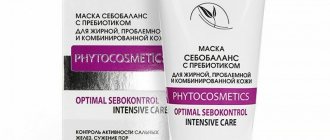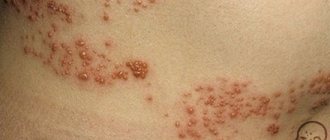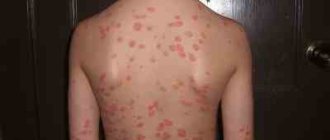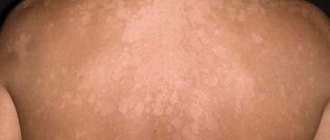There is a whole list of signs by which a practicing hepatologist determines that a person has a diseased liver: acne, a rash resembling urticaria, telangiectasia, hemangiomas and liver spots. All these are problems that are visualized on the skin. It, being the largest organ complex of the human body, takes on some of the functions of the exocrine gland and acts as a signaling device notifying about problems existing in it.
The presence of rashes can in a significant number of cases be associated with the loss of the liver's ability to remove toxic compounds. This leads to the accumulation of a significant amount of toxins that can cause the negative phenomenon of variable dislocation.
The body as a whole
Our body has an unusually complex organization, which today is not fully understood. Failures in the operation of some systems will directly or indirectly affect the functioning of others. Very often, the development of pathological processes in the body is signaled not only by general malaise and pain, but also by the condition of the facial skin.
Gastritis provokes rashes on the face
Every person should know that one of the most common causes of rashes on the face is improper functioning of the digestive system.
For example, rashes on the skin of the forehead can signal a violation of the intestinal microflora and pathologies of the gallbladder, pimples on the chin can pop up due to the accumulation of toxins in the body, etc.
Of course, a person can eliminate a cosmetic defect in the form of a pimple using special cosmetics or folk methods. However, the problem will appear again and again until measures are taken to diagnose and treat the disease causing the rash.
Diagnosis of the disease
At first, they don’t pay much attention to the appearance of acne. Antihistamine ointments, antiseptic and bactericidal agents are used, and the rash is covered with anti-acne cosmetics. If the use of local therapy does not lead to the desired result, you need to check the condition of the liver. The main cause of acne on the skin is damage to the liver and biliary tract, so timely diagnosis will help prevent the disease from starting and lead to a quick recovery.
If acne is not eliminated by means of direct action on it, it is necessary to be examined for the health of internal organs.
Who to contact:
- A consultation with a gastroenterologist is needed to check the digestive system and confirm the diagnosis.
- You need to visit a dermatologist who will prescribe cosmetics and antibiotic therapy, and create a special diet to reduce inflammation of the skin.
- It is important to consult an endocrinologist to exclude hormonal imbalances.
- In case of hormonal imbalance, birth control pills may be prescribed to reduce acne. To do this, you need to undergo an examination by a gynecologist.
- The opinion of specialists in oriental medicine is taken into account. They can prescribe herbal infusions and teas to cleanse the body, and develop a special diet.
Diagnostic procedures to detect the problem:
- general analysis of urine and blood, as well as a biochemical blood test (determination of liver tests - bilirubin, ALT, AST and the state of protein metabolism - cholesterol, serum protein and its fractions);
- coagulogram (blood clotting);
- ultrasound examination of the liver and gallbladder;
- MRI of the liver and biliary tract.
Why does the skin condition deteriorate with gastritis?
To understand why gastritis provokes rashes on the face, you need to know what this disease is. Gastritis is an inflammatory process in the gastric mucosa, which lines the inner surface of the organ.
Acne occurs in both acute and chronic gastritis
When a person develops gastritis, the food he eats is less digestible, which affects the person’s well-being and energy. A lack of nutrients and vitamins leads to fatigue, apathy, malaise and skin problems.
The rash can occur during both acute and chronic course of the disease; it can be localized on the skin of the face, abdomen and some other parts of the body.
One of the most common causes of rashes on the body is an allergic form of gastritis. It is provoked by the entry of an irritating substance into the digestive system, which in a particular person can cause an allergic reaction, most often - instantly appearing pimples. The allergen in this case can be either a food product or an inedible chemical compound.
If we look at the problem deeper, the culprit of this skin reaction is a pathogenic microorganism - the bacterium Helicobacter pylori. It is she who is credited with the development of many diseases of the gastrointestinal tract, including gastritis and gastric ulcers. Helicobacter pylori causes atopic dermatitis in the patient.
Wrinkles and sagging skin
Poisons and toxins from poorly filtered blood both chemically and simply mechanically damage collagen and elastic fibers. As a result, they either break up into smaller units or lose their dense structure. This causes them to lose their ability to retain moisture. The skin becomes flabby, dry, and the number of wrinkles rapidly increases.
However, the harm that poisons and blood toxins cause to our skin is not limited to the destruction of existing collagen and elastic fibers. They damage the actual dermal cells that produce these fibers. The degree of damage to cells and fibers directly depends on the degree of slagging in the liver and, accordingly, the amount of toxins and waste in the blood.
Another important task of the dermis is to supply the epidermis with oxygen and nutrients, for example, vitamins, proteins, minerals, trace elements and amino acids. The fact is that the epidermis itself does not have blood vessels, and therefore cannot feed independently. The entire dermis is permeated with many tiny blood capillaries. Normally, these two layers are inextricably linked to each other. However, as dermal cells are damaged by poisons and toxins, this connection is gradually destroyed. As a result, the epidermis receives insufficient oxygen and nutrients. The consequence of this is gray, sluggish, flabby, aging skin.
Types of acne with gastritis
Even before the appearance of clear clinical manifestations (in the form of nausea, heartburn, vomiting, etc.), only acne on the face or other parts of the body can indicate a stomach disease. In this case, it is useful for the patient to know by which rashes to recognize the beginning of the pathological process.
The allergic type of gastritis is characterized by a rash on the body similar to urticaria. It is represented by numerous inflammatory foci on the skin, which vary in size from 2 to 10 mm. The affected areas are very itchy, which can lead to scratching and infection in the wounds. Then the pimples transform into ulcers.
Allergic gastritis may cause urticaria
Most often, urticaria with allergic gastritis is localized in the lower abdomen; on the face, rashes appear mainly on the surface of the cheeks. In children, this symptom is in some cases accompanied by Quincke's edema (rapid swelling of the skin, subcutaneous tissue, and muscle tissue).
Some patients experience acne due to gastritis in the form of acne, or blackheads. Impaired absorption of nutrients due to damage to the gastric mucosa leads to the accumulation of toxins in the body, which it tries to remove through sebum. As a result, the skin pores become clogged with a sebaceous plug, the surface of which darkens during oxidation, causing blackheads to form on the face.
If the disease was caused by the microorganism Helicobacter pylori, then the rash on the skin will look like reddened bumps and blisters. In patients over 40 years of age, bacterial gastritis causes pinkish pimples.
If nausea, heartburn, belching, regular vomiting and abdominal pain are added to the skin lesions described above, then you should contact a qualified specialist as soon as possible.
Subcutaneous fat is “our body’s garbage bin”
Thanks to the dermis, a constant body temperature is maintained - around 37 degrees. Temperature regulation occurs automatically: tiny blood vessels (capillaries) in the dermis narrow in cold weather and expand in hot weather. Severe vasoconstriction is often noticeable on the surface of the skin, then it is called “goose bumps”. When the body overheats or undergoes intense physical work, the sweat glands, whose roots are also located in the dermis, begin to actively secrete sweat. It comes to the surface of the skin and evaporates there. Thus, the skin cools and protects the body from overheating. Poisons and toxins from poorly filtered blood enter the cells of the sweat glands and are released to the surface along with sweat. They can give sweat a particularly sharp and persistent unpleasant odor.
Subcutaneous fat is the deepest layer of the skin. It can be from a few millimeters to several centimeters thick. Fiber consists of loose connective tissue, the loops of which are filled with fat lobules of various sizes. A layer of fat is deposited primarily on the abdomen, sides, buttocks and thighs. It simultaneously serves as protection against shock, a thermal layer, an energy “depot”, and also as a garbage collector for our body. Nature has arranged it in such a way that fat cells must remove toxins and waste from the blood if they appear excessively. However, we can safely say that the whole life of a modern person is such a case. Protecting itself from poisoning, the cell seeks to enclose them in a fatty sarcophagus. Why? The fact is that fat is waterproof. As a result, toxins and waste become overgrown with a fat capsule, which, like a plastic bag, isolates them from the rest of the cell. Since new portions of toxins enter the blood of a modern person every second, fat cells operate in a mode of constantly increasing the fat sarcophagus. That’s why the kilograms lost as a result of diets and grueling workouts are back with us after a while, well, if not in excess!
The fiber tissue contains numerous nerve endings and hair roots. From there, from the hair follicles, hair grows at an angle to the surface of the skin. Near each hair follicle there are one or two sebaceous glands that secrete sebum. It lubricates the surface of the skin and hair.
How to treat acne with gastritis
To cope with a cosmetic problem on the face or stomach, it is necessary to cure the internal problem. And therefore, with gastritis, acne should be treated not by a cosmetologist, but by a gastroenterologist. If the stomach problem is solved or at least brought under control, then the rashes on the face will go away on their own.
For gastritis, complex therapy is used, which often includes a therapeutic diet and medication. In the case of an allergic form of the disease, treatment necessarily involves excluding the allergen from the patient’s diet.
Safety precautions: how to avoid relapse
Cleansing the liver and facial skin are connected, and the opposite effect in the form of the return of acne at the slightest problem with filtering toxins occurs constantly. How to prevent acne from returning after cleansing? There are several ways:
- once and for all formulate a diet that excludes foods harmful to the liver;
- give up alcohol - all organs will be grateful, not just the liver;
- give up strict diets that provoke fatty hepatosis;
- monitor your immunity, promptly treat all colds and infectious diseases;
- take hepatoprotectors in preventive courses as needed;
- drink more clean water;
- regularly breathe fresh and clean air in parks or gardens, preferably outside the city.
Quite simple tips that, unlike the strict prohibitions of a chronic patient, can be violated occasionally - one fried pie every couple of months will most likely not cause acne. And the best part: the rules can be supplemented with your own observations, because each organism is unique.
It is important to remember that acne resistant to cosmetic procedures and the liver have a very direct connection. Therefore, if suddenly acne and oily skin become a problem, you need to make an appointment with a hepatologist. Just in case.
Special diet
People with gastritis need to exclude very fatty, salty and spicy foods from their menu. Harmful mayonnaise as a salad dressing should be abandoned in favor of vegetable oils (sunflower, olive, flaxseed, etc.). Fatty pork should be replaced with leaner beef and poultry.
Diet will help quickly cure gastritis
Be sure to include fresh vegetables and fruits in your diet to provide the body with vitamins and microelements. This item can be replaced by taking a multivitamin complex, the choice of which should be consulted with your doctor. In particular, vitamins A and B5 are involved in the restoration of the gastric mucosa.
It is not necessary to categorically refuse confectionery and bakery products, but their consumption should be limited, since sugar is an excellent breeding ground for the proliferation of pathogenic microorganisms. For dessert, it is still recommended to eat a fruit or a handful of dried fruits. Also subject to restrictions are milk and its derivatives, any fish, citrus fruits, coffee, chocolate, and nuts.
The best heat treatments for food are steaming, boiling and baking. The number of meals per day should be 5-6, but the portions of the dishes should be small.
These simple diet rules will help the patient recover faster and get rid of acne on his face.
Sweat and body odor
The role of the skin as an organ of the human excretory system is very important. The sweat and sebaceous glands are the leading ones in performing this function. Sweat contains 98% water, 1% table salt dissolved in it and 1% metabolic products (urea, uric acid, ammonia), toxins and waste from the blood. The sebaceous glands secrete from 100 to 300 g of sebum during the week. It contains cholesterol, proteins, fatty acids, salts, as well as toxins and wastes that enter the sebaceous gland from the blood. That is why, in advanced stages of liver slagging, an unpleasant odor constantly emanates from the surface of the human body. In an effort to get rid of it, a person visits the shower several times a day and tries new and new deodorants. However, a few hours after the next shower, the smell is felt again.
Taking medications
If the diagnosis of gastritis shows that its causative agent is Helicobacter pylori, then the treating specialist prescribes the patient to take antimicrobial drugs. As a rule, these are drugs based on macrolides and ampicillin. Additionally, substances are prescribed that reduce the acidity of gastric juice. The therapeutic course is at least 2 weeks.
For gastritis with low stomach acidity, medications are used that increase the production of gastric juice. To improve digestion in the organ, the patient is prescribed enzyme preparations (for example, pepsin).
We must not forget that self-squeezing pimples with gastritis can introduce an infection under the skin. Then treatment of stomach disease may not save the patient from extensive purulent rashes on the face and other parts of the body. Therefore, if you notice a long-term deterioration in your skin condition, you must contact a medical institution for consultation, diagnosis and treatment.
The reason is not there at all
Acne is an acute problem for all teenagers. Not the best memories are associated with him. What could be worse than the appearance of another pimple on the eve of a date or an important meeting. Preventive measures do not solve the problem or have a temporary effect. Many live with this for many years, acquiring a lot of mental trauma and complexes in this area. Although the problem can be easily solved with simple knowledge.
It just so happens that a person will sooner believe an advertisement and the healing effect of an expensive cream than a simple and free solution. It’s hard to blame such people for anything, because powerful propaganda from marketers is directed in their direction. And advertising gimmicks are designed to make people become regular customers of pharmaceutical and cosmetology companies.
And let all these companies forgive me, but I want to talk about the real causes of acne and simple treatment methods.
Chin
Rashes on the lower jaw are a sure sign of hormonal imbalances; however, poorly functioning ovaries and appendages may be to blame. Also, the problem may well be hidden in improper digestion or diseases in the oral cavity.
Pimples around the mouth often appear due to diseases of the digestive system, for example, you may be worried about bloating, indigestion, intestinal colic and constipation. Most often, the entire digestive system is affected, from the esophagus to the large intestine.
In case of rashes on the neck, it is worth thinking about the state of the endocrine and digestive systems, namely the intestines and stomach. The most dangerous sign is acne on the neck, chin and forehead at the same time: this indicates ovarian dysfunction.
Bacterial zoo - or how to care for your skin
Often the skin is affected from both sides. On one side, toxins come out and cover it with a carpet of inflamed acne. On the other hand, we, in a panic, pour a bunch of products onto the skin, completely killing the protective microflora. In order to restore the protective layer, the body requires a lot of time and effort.
During periods of acne formation, it is advisable to use care products with a neutral pH level. Try not to use aggressive alcohol and alkaline solutions.
Pimples after shaving
Many men are familiar with the problem of acne breaking out after shaving. This is due to microdamage to the skin and its bacterial infection.
Dry shaving is safer than wet shaving. It does not injure the skin as much and causes fewer inflammatory reactions. In addition to cheap nickel blades, aggressive foams and aftershave lotions damage the skin. They wash away the protective fatty layer of the epidermis, leaving the skin completely unprotected. Lubricating strips on razors can cause allergies.
The optimal solution in this situation would be to increase the pauses between shaving processes. Selecting a “dry” razor that causes minimal damage to the skin. Minimize the use of alcohol-based care products before and after shaving.
There are also extreme methods to solve this problem - either do without shaving at all, or resort to procedures such as laser or wax hair removal.
Skin condition and vegetarianism
Vegetarians have clearer, healthier skin than meat eaters
Many experts recognize better skin condition in vegetarians than in meat eaters. This is due to the fact that products of plant origin contain less heavy processing waste. While the process of digesting meat involves bacteria that are not the most friendly to our body. While receiving a steady diet, they produce waste products that are toxic to our bodies. If their number exceeds the norm, the immune system does not have time to neutralize them and remove them from the body in time. Then their excesses are excreted through the skin and other excretory systems.
Often, people who switch to vegetarianism experience the appearance of acne. This is due to a radical change in the intestinal microflora and its shift to a healthier background. Pathogenic microflora dies, forming toxic compounds that enter the blood. The pancreas also rebuilds the production of enzymes. Because of this, during the first month you may experience increased gas formation and acne, which will go away on their own once this process is complete.
Cause of acne
Up to 70% of teenagers are predisposed to acne. This problem is associated with an increase in the activity of the sebaceous glands, a decrease in the bactericidal properties of the sebaceous layer, and, as a consequence, the proliferation of pathogenic flora. The basis for such changes are hormonal changes during puberty. But this is not the only reason, otherwise acne would go away on its own after 18 years.
The fact that acne persists into adulthood indicates a nutritional cause. Or rather, with the fact that the body signals us about its violations.
Skin problems? Check your intestines!
Having skin problems? Don’t rush to scrub, moisturize and subject it to other cosmetic collaborations. Our experts advise checking your intestines; perhaps the source of all troubles is hidden there.
Inna Tulina, Head of the Department of Oncological Coloproctology, Sechenov University
Vasily Firsov, cosmetologist-dermatovenereologist
The ancient thinkers were right a thousand times when they said: “We are what we eat.” You don't have to be clairvoyant to tell by your face your love for buns, chocolates and burgers. Will you say that all this is complete nonsense, that our body copes perfectly with cleansing on its own? You'll be right. But only partly.
Choosing a doctor
If you are immersed in biohacking - eat right, get enough sleep, breathe clean air and drink enough clean water - your body works like a clock, your skin glows even on gray November days. But living in a metropolis according to all the rules of a healthy lifestyle is difficult. And to be honest, each of us has our own top bad habits. If you, not sparing your intestines, prefer fast food to healthy food, work a lot and sleep little, you shouldn’t be surprised if something is wrong with your skin. The skin will always let you know if the body is not in order. As soon as you notice that it has not changed for the better, it has become very dry or too oily, rashes and itching have appeared, your complexion has become dull, it’s time to contact... no, not a cosmetologist, but a dermatologist. An experienced specialist will conduct a diagnosis and, if he understands that the cause of bad skin is hidden inside the body, will refer you to a gastroenterologist or coloproctologist.
What does the intestines have to do with it?
A healthy person has about 500 species of bacteria in their intestines. Normally, they all maintain a balance - some are antagonists to others and prevent diseases from developing, others work in tandem and prevent the proliferation of pathogenic bacteria. Beneficial bacteria help us digest food, enrich the body with nutrients, and help strengthen the immune system. They constantly work and regulate intestinal function, help break down proteins, fats and carbohydrates, and even synthesize some vitamins. And what’s most interesting is that they even affect the hormonal and nervous systems! Along with beneficial bacteria in the intestines live pathogenic ones, which are just waiting for the right moment to remind themselves. Pathogenic flora can be activated by weakened immunity, frequent stress, poor diet, or exacerbations of gastrointestinal diseases. Thus, due to disruption of the intestinal microflora, the absorption of nutrients may decrease, and thus the digestion process will be disrupted. Remains of undigested food will cause rumbling, bloating, swelling - and skin problems are inevitable. “The influence of the intestines on the skin is beyond doubt - the two organs are inextricably linked due to their common origin. Even in utero, the intestines and skin develop together and at the same time, so that in the process of life they become a reflection of each other, says Vasily Firsov. — The simplest example: with dysbacteriosis, the absorption of vitamins and minerals is impaired, and the less of them reaches the skin, the worse its protective properties: it becomes excessively pale, takes on a gray tint, will be dry, flabby, dries out faster from the wind or air conditioning, is susceptible to infections. These are general signs. There are also characteristic ones. If the absorption of B2 vitamins in the intestines is impaired, rashes in the form of papules appear in the corners of the mouth, which can become wet and crack. With a lack of sulfur entering the body, seborrheic dermatitis develops (lack of vitamin B2 is also related to this process). There may be various disorders in the form of petechiae, purpura due to a lack of vitamin K or impaired absorption. Vitamin deficiency can provoke iron deficiency, and then the face becomes very pale.” Second opinion.
“We are now actively studying and conducting laboratory research on how our lifestyle affects the intestinal microflora,” says Inna Tulina. — If we talk about the skin, its problems are often associated with external factors - poor ecology, dry air and the influence of all kinds of radiation. But we shouldn’t forget that we also get adverse effects from the inside - chlorinated water, products with preservatives - they also don’t have the best effect on the skin.”
Do you need a detox?
The phrase “skin detox” is liked not only by readers of fashion magazines, but also by cosmetologists and manufacturers of cosmetic products. Many people believe in this and even practice detox as a means for beautiful skin. But honest experts say that skin detox is nothing more than an advertising gimmick. A healthy body can carry out the detox procedure on its own. The liver and intestines work to a greater extent on removing toxins and waste, and when they fail, the body begins to draw on its reserves for elimination, the very first of which is the skin. “However, if the main pathways fail, an attempt to get rid of endotoxins can lead to various skin manifestations, because the skin is not adapted to remove waste products,” says Vasily Firsov. “This is why inflammatory reactions of the sebaceous and sweat glands occur. The situation is complicated by the fact that endotoxins can have a direct damaging effect on the epithelium of the ducts of the sebaceous and sweat glands. These are the so-called antigen-antibody complexes, which the body must eliminate when an allergen is received, for example, with food. Basically, this function is performed by the intestines; it can remove large molecules due to its area, but if the path is closed, the molecules will be removed by the skin. And since they are aggressive in themselves and have a damaging effect on cells, inflammation will occur on the skin.” Second opinion.
“It is important to understand that there is no such direct path as eating an apple and looking good or smoking and looking bad. Between the skin and the intestines there is a large buffer of various regulatory systems, including hormonal, nervous, endocrine, hematopoietic, etc. This buffer can be very wide in some people, while in others, on the contrary, it can be too narrow. And the smaller it is, the stronger the external manifestations on the skin,” says Inna Tulina.
Permitted procedures
“If we only suspect a connection between the skin and the gastrointestinal tract, we must clearly establish it and give related specialists the opportunity to conduct a diagnosis,” says Vasily Firsov. — Standard studies: blood tests for various inflammatory changes, studies of the biochemical composition of the blood (microelement composition, study of vitamin content, levels of hormones that affect digestion processes, blood glucose levels). Testing for systemic infections is mandatory. In some cases, you can even perform an ultrasound of the skin to determine the nature of the disease. The last resort we resort to is a skin biopsy to identify psoriatic processes, chronic dermatoses or atypical inflammatory changes in the skin, which are most often also caused by processes occurring in the body. And only when the cause of skin problems is finally identified, treatment is prescribed according to the principle of “do not irritate the irritated area.” To relieve acute inflammatory phenomena on the skin, soothing lotions, applications of glucocorticoids and external agents with corticosteroids are used. In general, everything that will calm the process. Treatment and rehabilitation are aimed at preventing the formation of hypertrophic changes in the skin. The task of a dermatologist is to prevent the replacement of collagen and elastin fibers with connective tissue and to prevent the development of fibrosis in the skin. Otherwise, it will lead to a disruption in appearance. In this situation, you can use skin care treatments and masks. Next, you need to help the skin cells perform their function effectively. To solve this problem, rehabilitation programs are used that are not programs for solving inflammatory problems. For example, you can use high-protein drugs - creams that contain protein (everyone hears placental, but this is not necessary). With drugs containing vitamin complexes, the situation is twofold. It makes no sense to add microelements to them. Even if we apply zinc to the skin, which is an essential trace element for beauty, it still won’t get inside. Therefore, for the rehabilitation of processes that have occurred on the skin, preparations containing collagen and hyaluronic acid are useful.” Second opinion.
“Based on skin symptoms, we cannot identify the cause of problems in the intestines and make a diagnosis. But maintaining intestinal health in order to cope with cosmetic problems is quite possible,” says Inna Tulina. — To achieve this, I recommend everyone to lead an active lifestyle. Movement maintains the functioning of all regulatory systems, including normal intestinal function. This is a good prevention of hemorrhoids, constipation, imbalance of microflora - all those problems that affect the skin. Proper nutrition is a must, perhaps even with episodes of fasting. Now there is a diet that imitates fasting, which is being tested under experimental conditions. The idea is that when a person does not eat for a long time, say from 12 to 16 hours, the person's microbiome - the composition of the microflora - is regulated. And this is due to the condition of the skin. When choosing products, preference is given to plant foods with a small amount of protein (meat, fish, poultry), excluding sugar, dairy and bakery products, especially baked goods.”
Tatyana Kondrashova, general practitioner, neurologist, specialist in orthomolecular medicine
We all know that skin health depends on internal and external factors. External factors include all the negative consequences of oxidative stress, poor ecology, and the effects of ultraviolet radiation on the skin. In addition, cosmetics containing a large percentage of silicones and petroleum products (such as mineral oil, petroleum jelly, paraffin) can cause deterioration of the skin. This can be expressed in the form of comedones, isolated inflammations, and allergic reactions. If the skin has good immunity, it is able to cope with such “attacks” from the outside, but sooner or later all this will affect the state of the skin microbiome (the balance of “bad” and “good” microorganisms on the surface of the skin). But skin health depends not only on the bacteria that live on its surface, but also on the intestinal microbiome. According to numerous studies, a clear connection has been identified between an imbalance in the composition of the intestinal microbiome and skin diseases such as acne, atopic dermatitis, psoriasis, not to mention the more active manifestation of age-related changes. It has been proven that food supplements with probiotics (strains of lacto- and bifidobacteria) have a positive effect on the mentioned skin diseases: its sensitivity decreases and hydration increases. Probiotic supplements with lactobacilli accelerate wound healing and improve skin recovery after sunburn, thereby slowing down the photoaging process.
Pimples on temples
The temples on both sides are a projection of the gallbladder. If there is an imbalance in its functioning, acne appears on the temples. Another culprit is the digestive system, namely poor nutrition. A clogged intestine simply releases toxins, and the blood carries them throughout the body. Further, liver function deteriorates, stomach acidity increases and dysbacteriosis occurs.
If pimples on your ears are your frequent guests, remember the last time you cleaned your phone. A huge number of bacteria live on it. Another reason is disruptions in the endocrine system and the initial stage of pathology of the gastrointestinal tract.
Bad diet = bad skin
Advertising on the Internet and on TV has probably already given you a bunch of miraculous creams, lotions and scrubs for acne. But, as you already understand, the root of the problem is diet.
We will not give here a list of products that spoil your skin - you already know them very well. Chocolate, pastries, sweet soda (with or without sugar) - if you eat all this every day, you shouldn’t be surprised by pimples all over your face and a stale appearance.
The main thing to pay attention to is the glycemic index of foods.
The connection between high GI foods and skin health is certainly noteworthy. It is this that provokes cystic forms of acne, severe acne and stimulates glycation of collagen.
This is the name given to the natural process of interaction between proteins and carbohydrates. It is this that underlies the mechanism of skin aging, but it can be either slowed down or accelerated with the help of “junk food” and alcohol.
The skin is the mirror of the digestive system
The face is a person’s calling card. From it you can immediately read your mood, psychological problems and overall health. Often, skin diseases are external manifestations of internal problems.
“What’s on your table is on your face”
The lack of food culture plays a cruel joke on us. People are not taught in school what processes occur in the body during nutrition and how foods affect our health. Over the past 100 years, the diet of modern man has changed dramatically. Trashy fats were invented and are abundantly present in confectionery and dairy products. Sugar consumption per capita has increased 20 times. Consumption of meat and milk has tripled. While the consumption of fruits and vegetables has reduced its growth by more than half.










